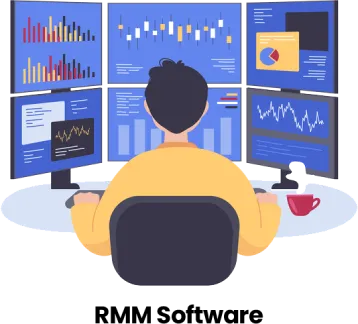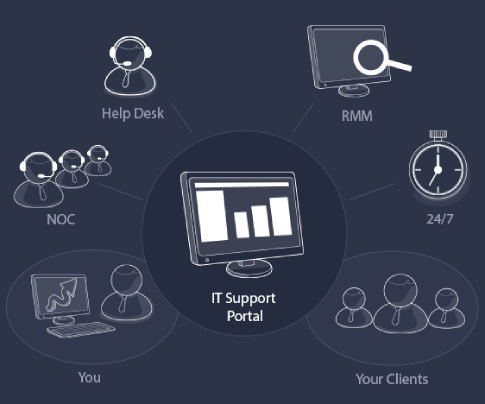The History of RMM Software
The evolution of Remote Monitoring and Management (RMM) software is a fascinating journey that mirrors the broader trends in information technology and managed services. RMM platform has its roots in the early days of networked computing. Still, it was the rise of managed service providers (MSPs) in the late 1990s and early 2000s that genuinely catalyzed its development into the sophisticated platforms we see today. This history is not just about the technology itself but also about the changing needs of businesses and the IT industry's response to those needs.

The Early Days: Pre-RMM Era
Before the advent of RMM, IT management was largely reactive and on-site. Technicians would physically visit the hardware to install, update, or repair systems. This approach was time-consuming, costly, and inefficient, especially as businesses began to rely more heavily on IT infrastructure for their daily operations. The need for a more proactive and efficient IT asset management became apparent.
Birth of Network Management Tools
The first step towards what would become RMM was the development of network management tools in the late 1980s and early 1990s. These tools allowed IT professionals to monitor network performance and troubleshoot issues from a central location. However, they were primarily focused on large networks and not designed to manage endpoints or provide the comprehensive management capabilities that modern RMM solutions offer.
Rise of Managed Service Providers
The concept of managed services began to take shape in the late 1990s, driven by the increasing complexity of IT environments and the need for businesses to focus on their core operations rather than IT management. MSPs offered a subscription-based model where businesses could outsource their IT management needs. This model required tools that could provide remote monitoring and management capabilities at scale, leading to the development of the first true RMM solutions.
Evolution of RMM Software
Early RMM software was focused on remote monitoring, allowing MSPs to monitor system health, network performance, and security alerts from a central dashboard. As the MSP model grew popular, RMM software evolved to include more comprehensive management features, such as remote access, automated maintenance, patch management, and backup and disaster recovery solutions.
The 2000s saw significant advancements in RMM technology, driven by the growth of cloud computing and the increasing complexity of IT environments. RMM solutions began to leverage cloud technology to offer more scalable and flexible management options. This era also introduced the integration of professional services automation (PSA) tools with RMM platform, allowing MSPs to streamline their operations further by linking remote management with billing, ticketing, and customer relationship management.
Modern RMM Platforms
Today's RMM platforms are highly sophisticated, offering many features beyond simple monitoring and management. They provide advanced analytics, predictive maintenance, integration with third-party applications, and enhanced security features to protect against cyber threats. Modern RMM solutions are designed to support diverse devices and operating systems, reflecting the heterogeneous nature of current IT environments.
Key Features of RMM Software
Remote Monitoring and Management (RMM) software is an indispensable tool for managed service providers (MSPs) and IT departments, offering a suite of capabilities designed to streamline the management of IT infrastructure. The key features of RMM software are central to its effectiveness, enabling proactive monitoring, management, and problem resolution across networks and devices. Here's a detailed look at these essential features:
Automated Monitoring and Alerts
RMM software monitors IT systems for health, performance, and security issues, including servers, workstations, network devices, and applications. It can automatically alert IT staff or MSPs when it detects problems or irregularities, such as low disk space, high CPU usage, or potential security breaches. This proactive approach helps identify and address issues before they escalate, minimizing downtime and potential damage.
Remote Access and Control
One of the core functionalities of RMM software is its ability to provide remote access to managed devices. This feature allows IT professionals to connect to devices anywhere in the world as if they were physically present, enabling them to troubleshoot issues, perform maintenance, update software, and configure settings without needing to be on-site. This speeds up resolution times and significantly reduces the costs associated with travel and on-site visits.
Patch Management
Keeping software up to date is crucial for security and performance. RMM software automates the process of downloading and applying patches and updates to operating systems and applications across all managed devices. This ensures that software vulnerabilities are promptly addressed, reducing the risk of security breaches and improving system reliability.
Asset Management
RMM tools include asset management features that provide a comprehensive overview of all IT assets within an organization. This includes tracking hardware, software, and network components, their configurations, and the status of warranties and licenses. Such visibility is crucial for effective IT inventory management, planning upgrades or replacements, and ensuring compliance with software licenses.
Performance Reporting and Analytics
RMM solutions offer detailed reporting and analytics capabilities, giving MSPs and IT departments insights into the health and performance of their IT infrastructure. These reports can include information on system uptime, security incidents, backup status, and the resolution times of support tickets. Such data is invaluable for strategic planning, improving IT services, and demonstrating the value of IT management to stakeholders.
Security Management
Enhanced security features in RMM software help protect against malware, ransomware, and other cyber threats. This includes managing firewalls, antivirus software, and implementing security policies. By centrally working security measures, RMM tools ensure that all endpoints are protected and that security updates are consistently applied across the network.
Backup and Disaster Recovery
RMM platforms often incorporate or integrate with backup and disaster recovery solutions to ensure data is regularly backed up and can be quickly restored in case of a system failure, data loss, or cyberattack. This feature is essential for maintaining business continuity and protecting against data breaches or loss.
Integration with PSA Tools
Integration with Professional Services Automation (PSA) tools is a significant feature for MSPs. This integration allows for seamless workflow between monitoring and management tasks and the business aspects of service delivery, such as billing, service ticketing, and customer relationship management. It enables MSPs to provide efficient, high-quality service while managing the business side of their operations effectively.
These critical features make RMM software a powerful ally for MSPs and IT departments, enabling them to manage and secure IT environments more efficiently, proactively, and cost-effectively. By leveraging RMM application, organizations can ensure high system performance and reliability levels, improve their security posture, and deliver superior IT support and services.
RMM Software FAQ
RMM (Remote Monitoring and Management) software is an application designed to help IT professionals and managed service providers (MSPs) remotely monitor and manage IT infrastructure, including computers, servers, mobile devices, and networks. It works by installing agents on the client's devices, which then communicate back to the MSP or IT professional's central dashboard. These agents provide real-time data on the health and performance of each device, allowing for proactive maintenance, immediate issue identification, and remote problem resolution without the need to visit the device location physically. This enables IT teams to efficiently manage large and distributed networks efficiently, ensuring optimal performance and minimizing downtime.
The benefits of using RMM software are extensive, offering both operational efficiencies and strategic advantages for businesses and IT service providers:
- Proactive Issue Resolution: Enables early detection of problems before they escalate, reducing downtime and potential damage.
- Increased Efficiency: Automates routine tasks like patch management and monitoring, allowing IT staff to focus on more strategic initiatives.
- Enhanced Security: Provides tools for managing updates, applying patches, and monitoring for security threats, helping to protect against data breaches and cyberattacks.
- Remote Support: Facilitates immediate remote assistance to end-users, improving response times and user satisfaction.
- Cost Savings: Reduces the need for on-site visits and allows for the efficient management of IT resources, translating into lower operational costs.
- Scalability: Easily scales to accommodate the growth of an organization’s IT infrastructure without significant increases in cost or complexity.
Choosing the right RMM software involves several considerations to ensure it aligns with your business needs and goals:
- Compatibility: Ensure the RMM software supports all devices and systems within your IT environment.
- Scalability: The solution should scale up as your business grows, managing an increasing number of devices without losing performance.
- Features: Evaluate the features offered, including monitoring, management, automation, reporting, and security capabilities, to ensure they meet your requirements.
- Ease of Use: The software should have an intuitive interface that allows your team to monitor and manage IT assets efficiently.
- Integration: Look for RMM solutions to integrate with your existing tools, such as PSA software, ticketing systems, and backup solutions, for a seamless workflow.
- Vendor Support: Consider the level of support and training the vendor offers. Good support can significantly ease the implementation process and ongoing management.
